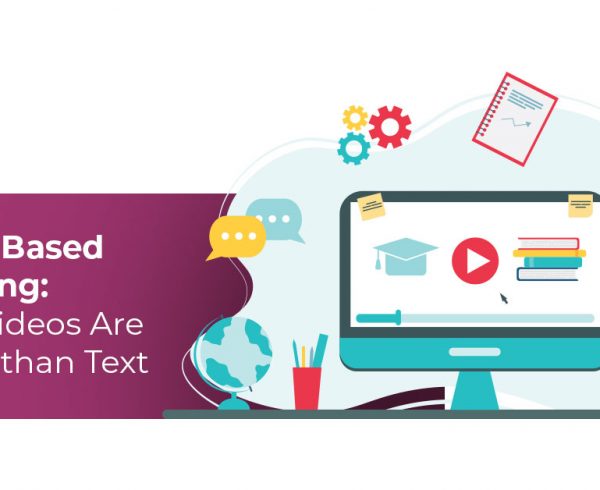The field of learning has witnessed revolutionary changes in the recent past. Students and teachers are moving ahead of the traditional chalk-and-talk method of teaching and learning and embracing video-based learning.
In a survey conducted, 74% of learners admitted that they employ video-based learning to make their learning more catchy, attractive, and impactful. Microsoft experimented with video-based learning and found it immensely helpful in reducing their learning delivery costs.
Table of Contents:
- Why Do You Need Video-Based Learning?
- Top 6 Highly Powerful Video-Based Learning Strategies
1. Promote Bite-Sized Learning
2. Deliver Interactive Learning Experiences
3. Create Relevant and Timely Updated Content
4. Make it Accessible
5. Monitor Your Audience’s Consumption Patterns
6. Take Timely Feedback From Students - Conclusion
This article details six time-tested, impactful video-based learning strategies you can implement to make your learning programs world-class.
Why Do You Need Video-Based Learning?
Here are the top reasons why video-based learning must occupy a prominent space in your higher education learning plan:
1. Engage Learners
A study found that learners remember a paltry 10% of a text while 65% of a video and a whopping 95% of audio-visual content. Hence, video-based learning might be the ultimate solution if you struggle to retain learners’ attention with conventional learning techniques.
2. Is Inclusive
You can usually find three types of learners in a class – visual, auditory, and kinesthetic. Since videos combine visuals, audio, and physical movement, they satisfy all types of learners.
3. Cost-Efficiency
Videos are more cost-efficient than all other modes of learning. For instance, if you have more than one learning facility, you have to hire multiple trainers for conducting learning sessions. However, if you create videos, you can send them to all learning centers, thereby saving money while making your sessions more resourceful.
The following sections discuss the six best video-based learning strategies to scale up your institute or organization’s reputation and brand value.
Top 6 Highly Powerful Video-Based Learning Strategies
To get the optimal output out of video-based learning, you must promote it as a perk, not an obligation. So, your videos must be catchy, attractive, creative, appropriate, topical, interactive, and readily available.
The following are the top video-based learning strategies adopted by institutions and organizations:
1.Promote Bite-Sized Learning
Bite-sized learning, also known as microlearning, has dominated the education landscape for quite some time. It helps learners select the units they want to learn and pick them up quickly. Microlearning is the ultimate solution if maximum efficiency with minimum time investment makes you happy.
Bite-sized learning is nothing but condensing the information into nuggets. For instance, if you want to teach adjectives, instead of creating one full-scale module, you may divide it into three parts – absolute, comparative, and superlative, and release one unit every day.
Since learners will focus on one topic a day, they can understand better and remember more. Creating and delivering bite-sized learning videos will be effective to promote student engagement.
2. Deliver Interactive Learning Experiences
Some people believe that video-based learning is a one-way process. Since learners cannot influence the video’s subject, they remain passive observers and not active participants. However, this is a half-truth.
Digital content solution providers like HurixDigital empower learners to take charge of their learning. You can create learning sessions with video and other materials like PDF, PPT, audio, etc., to offer an immersive experience to learners. Moreover, modern technologies like Augmented Reality (AI), Virtual Reality (VR), Artificial Intelligence (AI), etc., make content designing super smooth.
Hence, video-based learning might be a one-way process when you create a video alone. If you merge video with other content types, learners can get a better experience than the usual chalk-and-talk method of learning.
3. Create Relevant and Timely Updated Content
Video-based learning opens you up to a new world of possibilities. However, you can realize the full potential of video-based learning if you create relevant content and publish them at preset intervals. Remember, consistency is the key.
Many video creators create a stockpile of videos before launching their video-based learning campaigns. When you have a library of quality content, you can release them conveniently according to a schedule.
Also, before creating content, you must analyze the latest trends to make the videos as exciting as possible. To make your videos catchy, you can mix images with animations and music and attract the fancy of learners.
You might also like to read: 10 Ways to Use Videos in K-12 Education
4. Make it Accessible
Before creating video-based learning materials, you must set the technology straight. It is imperative to analyze your learners’ preferences before designing the content. Ask yourself questions like “Does the audience prefer watching the videos on their mobile or laptop?” “What is their age group?” “What is their demography?” etc.
After figuring out your audience’s needs and preferences, you can create the best video-based learning materials learners can access from anywhere and at any time they want.
5. Monitor Your Audience’s Consumption Patterns
Creating or publishing video-based learning materials makes you smart. But, if you want to become the smartest, you must analyze your audience’s consumption habits and modify your content accordingly. Fortunately, digital content solution providers make this kind of number crunching super easy. You can check the meticulously compiled reports to understand your audience’s preferences and make informed decisions.
Numbers speak louder than words. They can give insights into your audience’s content consumption patterns. Hence, analyzing the data must be an integral part of your video-based learning strategy.
6. Take Timely Feedback From Students
While data can give you good insights into your audience’s preferences, likes, and dislikes, you can engage with them personally to find what works and what does not. You can also create a logbook to record and retain learners’ feedback and use it to optimize the video-based learning materials.
Feedback is extremely important to scale up the content quality of the videos you release.
Conclusion
Learning is no more a one-size-fits-all activity. Educational institutions and corporate houses continually invest in R&D to make their learning materials more powerful and impactful. Video-based learning can provide you with the right thrust to improve your visibility and acceptability in the market.










